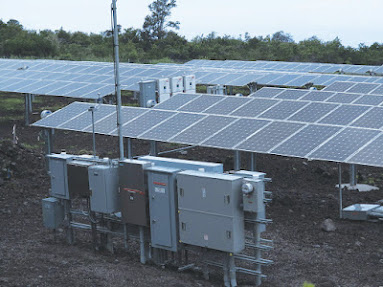 |
| A gathering of opponents to industrial solar in Ranchos and Kula Kai have established a legal fund for attorneys to fight the project. Photo by Peter Bosted |
The Public Utilities Commission recently granted a hearing. Ranchos resident and a leader in opposing industrial solar in neighborhoods is Peter Bosted. He told The Kaʻū Calendar, “We need the hearing to explain our case to the Commissioners. Without the chance to challenge the narrative peddled by the other side we could lose our case, even though we have the necessary evidence, simply because we don’t know how to argue.”
“We are not lawyers” explained Annie Bosted. “We are doing our best pro se, but since this hearing is hopefully our final hurdle, we have been strongly advised to get professional help to present our case in the best possible light."
She said that Stan and Mariann Troeller, owners of South Point U Cart, who have been doing business in Ranchos for 40 years, volunteered to match donations for the legal fund. They were immediately joined by a fellow Ranchos resident, who prefers to remain anonymous. Together they will equal any donation, past or future. Bosted said, each resident's donation will be doubled by the Troellers and “Mr. Anonymous. In other words, if anyone donates $100, the legal fund goes up by $200. We are hugely grateful to both Stan, Mariann and our shy angel for doing this.” She said the effort is helped by "two very keen and energetic lawyers, who regularly represent communities. They are enthusiastic about our case. This feels like a huge weight has been taken off our shoulders. With their help, I think we can win this thing.”
Ranchos community members first voiced opposition to the industrial solar project in their neighborhood on June 4, 2013 during a meeting with then-owner of the project, Pat Shudak who was CEO of Solar Hub Utilities.
“We are not lawyers” explained Annie Bosted. “We are doing our best pro se, but since this hearing is hopefully our final hurdle, we have been strongly advised to get professional help to present our case in the best possible light."
She said that Stan and Mariann Troeller, owners of South Point U Cart, who have been doing business in Ranchos for 40 years, volunteered to match donations for the legal fund. They were immediately joined by a fellow Ranchos resident, who prefers to remain anonymous. Together they will equal any donation, past or future. Bosted said, each resident's donation will be doubled by the Troellers and “Mr. Anonymous. In other words, if anyone donates $100, the legal fund goes up by $200. We are hugely grateful to both Stan, Mariann and our shy angel for doing this.” She said the effort is helped by "two very keen and energetic lawyers, who regularly represent communities. They are enthusiastic about our case. This feels like a huge weight has been taken off our shoulders. With their help, I think we can win this thing.”
Ranchos community members first voiced opposition to the industrial solar project in their neighborhood on June 4, 2013 during a meeting with then-owner of the project, Pat Shudak who was CEO of Solar Hub Utilities.
Years earlier, using a shell company, said Bosted, "Mr. Shudak secretly purchased 20 housing lots – 19 in Ranchos and one in Kula Kai. While these lots were still in escrow, Shudak acquired 18 places in the very lucrative Feed In Tariff Program, which was designed to kick-start solar power generation in Hawai’i. He chose lots that were close to the three-phase power lines that are located on the western side of Ranchos and in Kula Kai."
She said the PUC hired an independent observer to monitor Feed In Tariff applications. The independent observer's report was picked up by Civil Beat. Its story described Solar Hub’s flipping the Ranchos and Kula Kai lots and entitlements for big profits as blatant “queue squatting and gaming.” SPI, the company that plans to build the solar installations, is based in Shanghai. It owns the lots through a shell company named Calwaii, said Bosted.
In 2016, after the Bosteds filed a formal complaint with the PUC, the project was put on hold, and is still on hold. No site work has been done, and there is no formal contract, nor Power Purchase Agreement between HELCO and SPI. However, SPI is moving on finalizing approvals and agreements, said Bosted. She said, "If the Ocean View project is built, SPI will be paid 24cents per kWh -while modern solar projects, which include battery storage, will be paid less than 9cents per kWh. The cost of purchased power is passed directly to the ratepayers by HELCO. Since the power to be generated in Ocean View is far from the “load” – where the power will be used – power will be lost in the transmission, which also becomes a ratepayer expense."
In 2016, after the Bosteds filed a formal complaint with the PUC, the project was put on hold, and is still on hold. No site work has been done, and there is no formal contract, nor Power Purchase Agreement between HELCO and SPI. However, SPI is moving on finalizing approvals and agreements, said Bosted. She said, "If the Ocean View project is built, SPI will be paid 24cents per kWh -while modern solar projects, which include battery storage, will be paid less than 9cents per kWh. The cost of purchased power is passed directly to the ratepayers by HELCO. Since the power to be generated in Ocean View is far from the “load” – where the power will be used – power will be lost in the transmission, which also becomes a ratepayer expense."
To read comments, add your own, and like this story, see facebook.com/kaucalendar. See latest print edition at kaucalendar.com, in the mail and on stands.
 |
| Proposed new Hawaiian Volcano Observatory building in Hilo on state land at University of Hawai'i. Photo from Draft Environmental Assessment |
USGS WILL MAINTAIN FIELD STATIONS IN HAWAI'I VOLCANOES NATIONAL PARK, but its main new headquarters on this island will be at University of Hawai'i-Hilo, as shown in a Draft Environmental Assessment just published Thursday in The Environmental Notice. See the details at
https://files.hawaii.gov/dbedt/erp/The_Environmental_Notice/2023-02-23-TEN.pdf.
USGS Hawaiian Volcano Observatory was formerly located on the edge of Kilauea Crater. It was destroyed by the Kilauea Eruption in 2018 with the crater collapse and many earthquakes. Also destroyed was Jaggar Museum at the same location.
According to the Environmental Notice and Draft EA, the new headquarters will be a three-story facility off Komohana St., fronting Nowelo St. in Hilo. The proposed new location “allows HVO and PIERC to work collaboratively with university faculty and students and strengthen academic and research partnerships. The site is part of a larger parcel granted to the University of Hawai‘i by Executive Order 3814 in 2000. The UH Hilo fully supports the project and will execute a Use and Occupancy Agreement with USGS.”
https://files.hawaii.gov/dbedt/erp/The_Environmental_Notice/2023-02-23-TEN.pdf.
USGS Hawaiian Volcano Observatory was formerly located on the edge of Kilauea Crater. It was destroyed by the Kilauea Eruption in 2018 with the crater collapse and many earthquakes. Also destroyed was Jaggar Museum at the same location.
According to the Environmental Notice and Draft EA, the new headquarters will be a three-story facility off Komohana St., fronting Nowelo St. in Hilo. The proposed new location “allows HVO and PIERC to work collaboratively with university faculty and students and strengthen academic and research partnerships. The site is part of a larger parcel granted to the University of Hawai‘i by Executive Order 3814 in 2000. The UH Hilo fully supports the project and will execute a Use and Occupancy Agreement with USGS.”
 |
| Former headquarters of Hawaiian Volcano Observatory on the edge of Kilauea caldera, irreparable after the 2018 eruption. Photo from Wikipedia |
One of the other reasons given for moving the USGS facility to Hilo in the Draft EA is that Hilo has a lower risk of lava flow.
In the new building, the first floor will include laboratory bays, private and open offices, conference rooms, work areas, and a main lobby. The ground floor will be occupied by USGS Hawaiian Volcano Observatory. The second floor will include similar laboratory bays, offices, and work areas, and will be occupied by Pacific Island Ecosystem Research Center, which is currently located in Hawai'i Volcanoes National Park. The third floor of the building will include mechanical space and an open observation deck.
According to the Draft EA, "The Warehouse and Field Support building will support HVO and PIERC operations and serve as a bridge between laboratory and field functions. Most of the interior will be an open plan warehouse with 18-foot minimum clearance and a high loading access bay. The building will include administrative spaces, a climate-controlled room for the USGS archives; field gear storage and maintenance areas, and lockers/restrooms/showers. At the far east end of the building there will be labs and lab support spaces for PIERC, an insectary and animal housing area separated from the main building. A 11 ft x 99 ft linear greenhouse will be situated along the southern side of the warehouse and under the large overhanging roof."
See more in the Draft EA at https://files.hawaii.gov/dbedt/erp/The_Environmental_Notice/2023-02-23-TEN.pdf. Public comment is due March 28.
To read comments, add your own, and like this story, see facebook.com/kaucalendar. See latest print edition at kaucalendar.com, in the mail and on stands.
After a review of all updated crashes, Hawai‘i Police Department’s Traffic Services Section announced 131 major collisions so far this year compared with 100 during the same period last year, an increase of 31 percent.
To date, there have been three fatal crashes, resulting in four fatalities, (Rvsd. 02/07/23: one fatal crash reclassified—manner of death was due to natural causes) and (one fatal crash had multiple deaths); compared with five fatal crashes, resulting in seven fatalities (one of which had multiple deaths) for the same time last year. This represents a decrease of 40 percent for fatal crashes, and 42.9 percent for fatalities.
HPD promises that DUI roadblocks and patrols will continue island wide.
To read comments, add your own, and like this story, see facebook.com/kaucalendar. See latest print edition at kaucalendar.com, in the mail and on stands.
COMMUNITY MEETINGS
|
Free Meals Mondays, Wednesdays, and Fridays are served from 12:30 p.m. to 3:30 p.m. at Nā'ālehu Hongwanji. Volunteers prepare the food provided by 'O Ka'ū Kākou with fresh produce from its gardens on the farm of Eva Liu, who supports the project. Other community members also make donations and approximately 150 meals are served each day, according to OKK President Wayne Kawachi.
OUTDOOR MARKETS
Volcano Evening Market, Cooper Center, Volcano Village, Thursdays, 3 p.m. to 6 p.m., with live music, artisan crafts, ono grinds, and fresh produce. See facebook.com.
Volcano Swap Meet, fourth Saturday of the month from 8 a.m. to noon. Large variety of vendors with numerous products. Tools, clothes, books, toys, local made healing extract and creams, antiques, jewelry, gemstones, crystals, food, music, plants, fruits, and vegetables. Also offered are cakes, coffee, and shave ice. Live music.
-1.jpg) |
| https://www.okaukakou.org/scholarships-for-local-students |
Ka'ū Kākou Market, Nā'ālehu, Wednesdays, 8 a.m. to 2 p.m. Contact Nadine Ebert at 808-938-5124 or June Domondon 808-938-4875. See facebook.com/OKauKakouMarket.
Ocean View Community Market, Saturdays and Wednesdays, 6:30 a.m. to 2 p.m., corner Kona Dr. Drive and Hwy 11, near Thai Grindz. Masks mandatory. 100-person limit, social distancing required. Gate unlocked for vendors at 5:30 a.m., $15 dollars, no rez needed. Parking in the upper lot. Vendors must provide their own sanitizer. Food vendor permits required. Carpooling is encouraged.






